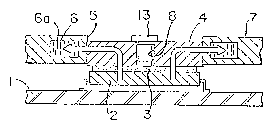Une partie des informations de ce site Web a été fournie par des sources externes. Le gouvernement du Canada n'assume aucune responsabilité concernant la précision, l'actualité ou la fiabilité des informations fournies par les sources externes. Les utilisateurs qui désirent employer cette information devraient consulter directement la source des informations. Le contenu fourni par les sources externes n'est pas assujetti aux exigences sur les langues officielles, la protection des renseignements personnels et l'accessibilité.
L'apparition de différences dans le texte et l'image des Revendications et de l'Abrégé dépend du moment auquel le document est publié. Les textes des Revendications et de l'Abrégé sont affichés :
| (12) Brevet: | (11) CA 1290078 |
|---|---|
| (21) Numéro de la demande: | 1290078 |
| (54) Titre français: | AGENCEMENT CALOPORTEUR POUR COMPOSANTS GENERATEURS DE CHALEUR MONTES SUR UN SUBSTRAT |
| (54) Titre anglais: | COOLING STRUCTURE FOR HEAT GENERATING ELECTRONIC COMPONENTS MOUNTED ON A SUBSTRATE |
| Statut: | Périmé et au-delà du délai pour l’annulation |
| (51) Classification internationale des brevets (CIB): |
|
|---|---|
| (72) Inventeurs : |
|
| (73) Titulaires : |
|
| (71) Demandeurs : |
|
| (74) Agent: | SMART & BIGGAR LP |
| (74) Co-agent: | |
| (45) Délivré: | 1991-10-01 |
| (22) Date de dépôt: | 1988-07-22 |
| Licence disponible: | S.O. |
| Cédé au domaine public: | S.O. |
| (25) Langue des documents déposés: | Anglais |
| Traité de coopération en matière de brevets (PCT): | Non |
|---|
| (30) Données de priorité de la demande: | |||||||||||||||
|---|---|---|---|---|---|---|---|---|---|---|---|---|---|---|---|
|
ABSTRACT
A cooling structure for cooling heat generating elec-
tronic components mounted on a substrate is disclosed. It includes
a cold plate fixed on the substrate which is provided with first
through holes opposed to the upper surfaces of the heat generating
electronic components. Flow paths are formed inside the cold
plate for circulating a coolant. An inlet is provided on a side
of the cold plate for supplying the coolant to the flow paths.
An outlet is provided on a side of the cold plate for exhausting
the coolant from the flow paths. Pistons are inserted and
held inside the through holes so that the lower surfaces of the
pistons come into contact with the upper surfaces of the heat
generating electronic components.
Note : Les revendications sont présentées dans la langue officielle dans laquelle elles ont été soumises.
Note : Les descriptions sont présentées dans la langue officielle dans laquelle elles ont été soumises.

2024-08-01 : Dans le cadre de la transition vers les Brevets de nouvelle génération (BNG), la base de données sur les brevets canadiens (BDBC) contient désormais un Historique d'événement plus détaillé, qui reproduit le Journal des événements de notre nouvelle solution interne.
Veuillez noter que les événements débutant par « Inactive : » se réfèrent à des événements qui ne sont plus utilisés dans notre nouvelle solution interne.
Pour une meilleure compréhension de l'état de la demande ou brevet qui figure sur cette page, la rubrique Mise en garde , et les descriptions de Brevet , Historique d'événement , Taxes périodiques et Historique des paiements devraient être consultées.
| Description | Date |
|---|---|
| Inactive : CIB de MCD | 2006-03-11 |
| Inactive : CIB de MCD | 2006-03-11 |
| Le délai pour l'annulation est expiré | 2000-10-02 |
| Lettre envoyée | 1999-10-01 |
| Accordé par délivrance | 1991-10-01 |
Il n'y a pas d'historique d'abandonnement
| Type de taxes | Anniversaire | Échéance | Date payée |
|---|---|---|---|
| TM (catégorie 1, 6e anniv.) - générale | 1997-10-01 | 1997-09-16 | |
| TM (catégorie 1, 7e anniv.) - générale | 1998-10-01 | 1998-09-17 |
Les titulaires actuels et antérieures au dossier sont affichés en ordre alphabétique.
| Titulaires actuels au dossier |
|---|
| NEC CORPORATION |
| Titulaires antérieures au dossier |
|---|
| SHINJI MINE |
| TERUMI SHIMONISHI |